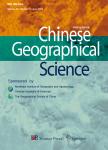Spatial-temporal Analysis and Prediction of Precipitation Extremes: A Case Study in the Weihe River Basin, China
Spatial-temporal Analysis and Prediction of Precipitation Extremes: A Case Study in the Weihe River Basin, China作者机构:State Key Laboratory of Soil Erosion and Dryland Farming on the Loess PlateauInstitute of Soil and Water ConservationChinese Academy of Sciences and Ministry of Water ResourcesYangling 712100China University of Chinese Academy of SciencesBeijing 100049China State Key Laboratory of Soil Erosion and Dryland Farming on the Loess PlateauInstitute of Soil and Water ConservationNorthwest Agriculture and Forestry UniversityYangling 712100China
出 版 物:《Chinese Geographical Science》 (中国地理科学(英文版))
年 卷 期:2022年第32卷第2期
页 面:358-372页
核心收录:
学科分类:0830[工学-环境科学与工程(可授工学、理学、农学学位)] 07[理学] 08[工学] 081501[工学-水文学及水资源] 0815[工学-水利工程] 0706[理学-大气科学]
基 金:Under the auspices of National Key Research and Development Program of China(No.2017YFE0118100-1)。
主 题:precipitation extremes space-time cube(STC) ensemble empirical mode decomposition(EEMD) long short-term memory(LSTM) auto-regressive integrated moving average(ARIMA) Weihe River Basin,China
摘 要:Extreme precipitation events bring considerable risks to the natural ecosystem and human life.Investigating the spatial-temporal characteristics of extreme precipitation and predicting it quantitatively are critical for the flood prevention and water resources planning and management.In this study,daily precipitation data(1957–2019)were collected from 24 meteorological stations in the Weihe River Basin(WRB),Northwest China and its surrounding areas.We first analyzed the spatial-temporal change of precipitation extremes in the WRB based on space-time cube(STC),and then predicted precipitation extremes using long short-term memory(LSTM)network,auto-regressive integrated moving average(ARIMA),and hybrid ensemble empirical mode decomposition(EEMD)-LSTM-ARIMA models.The precipitation extremes increased as the spatial variation from northwest to southeast of the WRB.There were two clusters for each extreme precipitation index,which were distributed in the northwestern and southeastern or northern and southern of the WRB.The precipitation extremes in the WRB present a strong clustering pattern.Spatially,the pattern of only high-high cluster and only low-low cluster were primarily located in lower reaches and upper reaches of the WRB,respectively.Hot spots(25.00%–50.00%)were more than cold spots(4.17%–25.00%)in the WRB.Cold spots were mainly concentrated in the northwestern part,while hot spots were mostly located in the eastern and southern parts.For different extreme precipitation indices,the performances of the different models were different.The accuracy ranking was EEMD-LSTM-ARIMALSTMARIMA in predicting simple daily intensity index(SDII)and consecutive wet days(CWD),while the accuracy ranking was LSTMEEMD-LSTM-ARIMAARIMA in predicting very wet days(R95 P).The hybrid EEMD-LSTM-ARIMA model proposed was generally superior to single models in the prediction of precipitation extremes.



